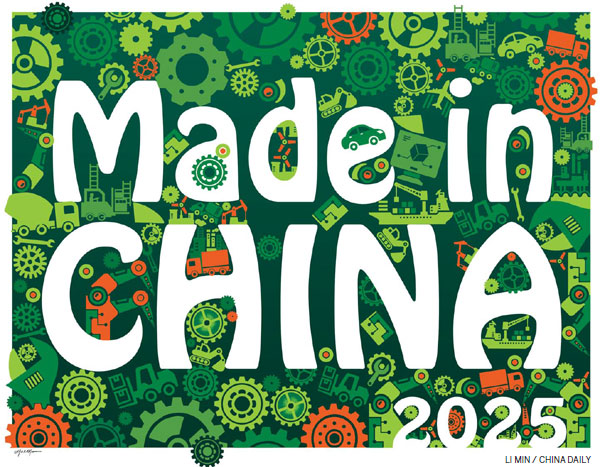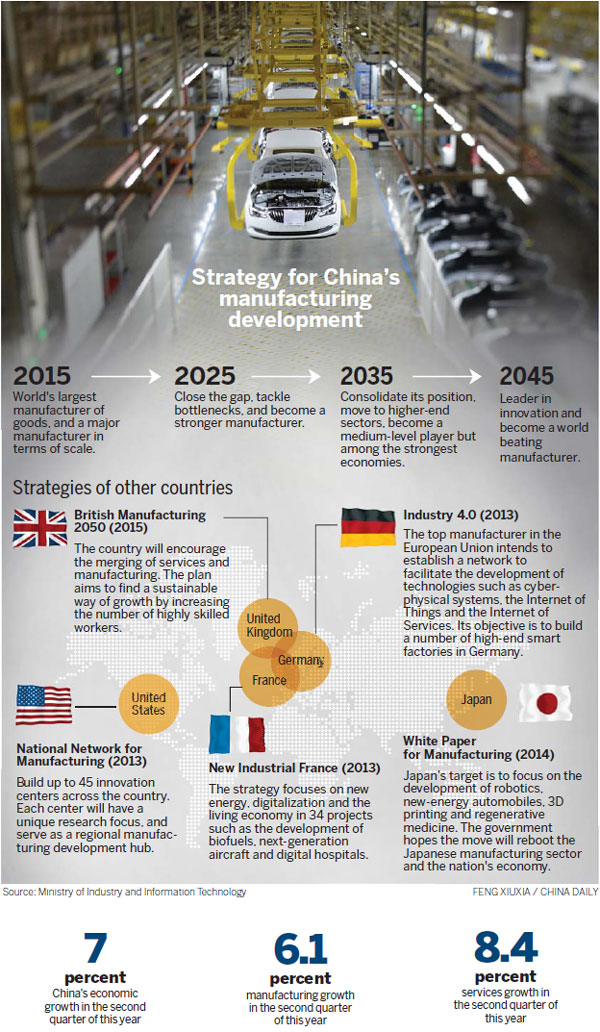
China has a new mission: Upgrade manufacturing processes to become leader in innovation
Victor X. Liu could be the new face of China's manufacturing.
The 42-year-old, who has a doctorate in power electronics from Virginia Tech in Blacksburg, Virginia, is far removed from the entrepreneurs who used to turn out plastic toys and other inexpensive products on China's southern and eastern coasts as the country became the workshop of the world.


He is chief executive officer and president of Focuslight Technologies, which is based in the Xi'an High-tech Industries Development Zone in northwestern China.
The company, which makes semiconductor lasers that have applications in 3D printing as well as medical uses in skin rejuvenation and in dentistry, could be a model for the Chinese government's Made in China 2025 strategy launched in May.
The government wants to focus on 10 key sectors, including robotics, information technology, aerospace, maritime equipment and high-tech shipping, high-speed rail and new energy vehicles.
"This is the new economy and about upgrading the manufacturing process. We are a high-tech company making a product that is not only very competitive in China but also in the world," he says.
Made in China 2025 is, in fact, the first 10-year phase of a 30-year program to upgrade China's manufacturing sector. The aim by 2045 is for the country to become a leader in innovation.
China is not the only country to launch such plans. The United States came up with its National Network for Manufacturing strategy in 2013 to build 45 innovation centers to serve as regional manufacturing development hubs.

In Europe, Germany has unveiled its Industry 4.0 plan aiming to build high-end smart factories, the United Kingdom has launched its British Manufacturing 2050 strategy and France its New Industrial France plan focusing on key industries such as new energy and digitalization.
That China should have a renewed focus on manufacturing may seem at odds with the government's aim to rebalance the economy toward being more services-led.
Chinese Premier Li Keqiang said in 2013 he saw developing services as a "strategic measure" to upgrade the economy.
Cai Hongbin, dean of the Guanghua School of Management at Peking University and also a member of the National People's Congress, China's legislature, insists the 2025 plan is a timely restatement of the value of manufacturing to the Chinese economy.
"People say that services is good and manufacturing is bad but I completely disagree with this. I think if the manufacturing sector becomes stronger then the services sector will grow from that.
"I think the plan is a really good policy target to signal the importance of manufacturing. I think that until now there hasn't been enough attention paid to manufacturing."
One of the reasons manufacturing has been downplayed is that with labor costs rising dramatically over the last decade, China has been unable to remain a low-cost producer.
Those reliant on cheap labor have been forced to shift their production to countries such as Vietnam, Cambodia, Bangladesh and even African countries.
Liu at Focuslight says China can no longer engage in this so-called race to the bottom.
Unlike China's earlier pioneering manufacturers, his company is not dependent on cheap labor.
Labor, in fact, only makes, up 15 percent of the company's direct product cost (when research and developments costs are excluded), compared with 60 to 65 percent for low-cost manufacturing.
Of his 300 employees, around 130 have master's or doctorate degrees.
"When I go and see customers in Europe or the US, I say that although we are located in China we are not a typical Chinese low-price company," he says.
Liu says he has to go to considerable lengths to overcome this perception of Chinese manufacturing being associated with low-end technology.
"I ask them whether they have any new projects and say that we are willing to support and help them for free at the initial stage. I tell them they have nothing to lose since they can still work with our competitors in the US and Europe who will be charging them a development fee. We then prove we can produce a prototype within three months that is sometimes better or at least as good as our rivals. This is the way we have to work."

One of the aims of the 2025 strategy is to address weaknesses in research and development, product quality, dependence on low-end production, information technology and an inability to connect with global production and supply chains.
The strategy seeks to address certain key "bottlenecks", which the government says are hampering China's economic development.
For example, China spent $220 billion (197 billion euros) last year importing integrated circuits, more than it spent buying oil around the world. The aim is for China to make such products itself.
Wu Changqi, professor of strategic management at Guanghua School of Management, insists that whether the strategy is successful will depend on how it is implemented.
"I think it is important that it is not completely a top-down approach and also involves a lot of market mechanisms. It should not just be an industrial policy offering cheap bank loans and grants to companies working in particular sectors."
Wu says it is also important to maintain competition and not just protect domestic producers.
"If you want to promote electric cars, for example, you need to have a level playing field between Chinese and foreign companies. It is no good giving a subsidy of 50,000 yuan to a Chinese manufacturer for every electric car it makes. It is better to give it to the consumer so they can choose the best electric car on the market."
Shaun Breslin, professor of politics and international studies at Warwick University in the UK, says debates in China about moving up the manufacturing value chain date back to the 1980s.
"I don't think it is a matter of just saying it, you have to put a whole lot of other things in place so that innovation can actually happen. This brings up a whole series of thorny questions that go directly back to the education system and whether it allows sufficient freedom of thinking to create genuine innovation."
Despite the renewed focus on manufacturing, the sector is no longer the main driver of the economy.
It grew by only 6.1 percent in the second quarter of this year, down from 6.4 percent in the first quarter, and slower than the overall rate of economic growth of 7 percent.
Meanwhile, services - which already comprise a larger proportion of GDP than manufacturing - grew by 8.4 percent in the second quarter, up from 7.9 percent in the first.
It brings into question whether China should follow the UK and US model where services are around 80 percent of the overall economy or the German one, where manufacturing remains the key driver.
Shi Yongjiang, research director of the Centre for International Manufacturing at Cambridge University, says this is a more complex question than many assume because there is an increased blurring between what can be defined as manufacturing and what a service industry.
"If you take Rolls Royce, the aero-engine maker, for example, around half of its profits come from leasing its engines to airlines and providing the finance for that. So is this a service or is it manufacturing? You have this definitional problem everywhere now."
For William Kirby, T.M. Chang Professor of China Studies at Harvard University, regardless of these definitions, the role model for China has to be Germany.
"Who would not want to be like Germany? Even with a relatively high-cost base, it manages to maintain its manufacturing advantage extraordinarily well. It has an excellent school system that places emphasis on vocational training and has built a real strong base in this sector. As a result, Germany has managed to hang onto industries the US has just failed to."
Cai at Guanghua School of Management does not believe that China has any choice but to focus on manufacturing because it could take several generations before it could compete with the US and the UK in services.
"China is at a very different development stage compared with these countries. It is still in the early to middle stages of industrialization. We are not in a position to jump to a post-industrial society. If China loses its manufacturing, it is losing the foundation on which future growth can be built."
Kirby says specializing in both services and manufacturing could be the future because he argues that a country as big as China has to have more than one industrial development model.
"It is like looking at Europe and considering that both Greece and Germany are the same. They are clearly not. I expect in China certain areas of the country will be known for the strengths in one sector and others for their strength in another."
The Harvard academic is particularly excited by the prospects for Zhejiang, the eastern province and one of the areas where Chinese low-cost manufacturing flourished after reform and opening up.
"Zhejiang is a place of great entrepreneurship because it has so few state-owned enterprises. I can imagine it will become a place in the future known for e-commerce and high-end manufacturing. I think Made in Zhejiang may become a more important label than Made in China."
Lu Hongyan and Du Juan contributed to this story.
andrewmoody@chinadaily.com.cn
|
The Xi'an High-tech Industries Development Zone in northwestern China's Shaanxi province. Provided to China Daily |
(China Daily Africa Weekly 09/11/2015 page1)








